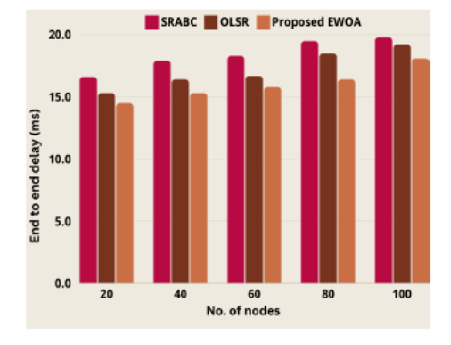


Indian Journal of Science and Technology
DOI: 10.17485/IJST/v17i21.3092
Year: 2024, Volume: 17, Issue: 21, Pages: 2138-2149
Original Article
S Jahir Hussain1*, Ramalingam Sugumar2
1Research Scholar, Department of Computer Science, Christhuraj College, Affiliated to Bharathidasan University, Trichy, Tamil Nadu, India
2Professor, Department of Computer Science, Christhuraj College, Affiliated to Bharathidasan University, Trichy, Tamil Nadu, India
*Corresponding Author
Email: [email protected]
Received Date:04 April 2024, Accepted Date:29 April 2024, Published Date:21 May 2024
Objectives: The research goal is to identify node-disjoint pathways maximizing path lifetime, delivery ratio, etc. while establishing several node-disjoint paths to optimize routing and enhance interference reduction and PDR efficiency. Methods: In the MANET, the Enhanced Whale Optimization Algorithm (EWOA) is utilized to discover the most secure routing path. The dataset used in this research comprises simulated scenarios representing various network conditions and configurations, allowing for a comprehensive evaluation of the proposed work. The software employed for simulation and analysis includes an NS-3 network simulation tool, allowing the model to evaluate the performance of the proposed routing protocol in diverse MANET scenarios. The parameters considered during the evaluation include throughput, end-to-end delay, packet delivery ratio (PDR), and routing overhead. The modifications involve enhancing the routing algorithm to prioritize node-disjoint pathways, thus improving interference reduction, energy efficiency, and overall network performance. Findings: The EWOA for Multi-Objective Node Disjoint Routing demonstrates superior performance compared to existing routing protocols such as SRABC and OLSR across various key metrics. Specifically, in terms of end-to-end delay, EWOA consistently outperforms SRABC and OLSR by reducing delay by 1.3% and 4.7%, respectively. Additionally, EWOA achieves a higher packet delivery ratio, surpassing SRABC and OLSR by 4.3% and 0.4%, respectively. Moreover, EWOA exhibits higher throughput, with a throughput increase of 11.3% compared to SRABC and 6.2% compared to OLSR. Furthermore, EWOA demonstrates lower routing overhead, reducing overhead by 9.6% compared to SRABC and 3.1% compared to OLSR. These findings highlight the efficacy of EWOA in optimizing multi-objective routing in MANETs, offering improved network performance and efficiency compared to existing protocols. Novelty: The Multi-Objective Node Disjoint Routing Protocol with Enhanced Whale Optimization is utilized in MANET to choose the best route, reducing latency resulting from link failure and distributing traffic loads across multiple paths.
Keywords: Optimization, Whale Optimization Algorithm (WOA), Optimized Link State Routing (OLSR), Secure Routing Algorithm Blockchain Technology (SRABC)), MANET
2024 Hussain & Sugumar. This is an open-access article distributed under the terms of the Creative Commons Attribution License, which permits unrestricted use, distribution, and reproduction in any medium, provided the original author and source are credited. Published By Indian Society for Education and Environment (iSee)
Subscribe now for latest articles and news.